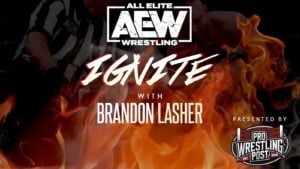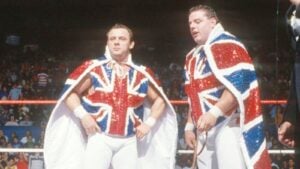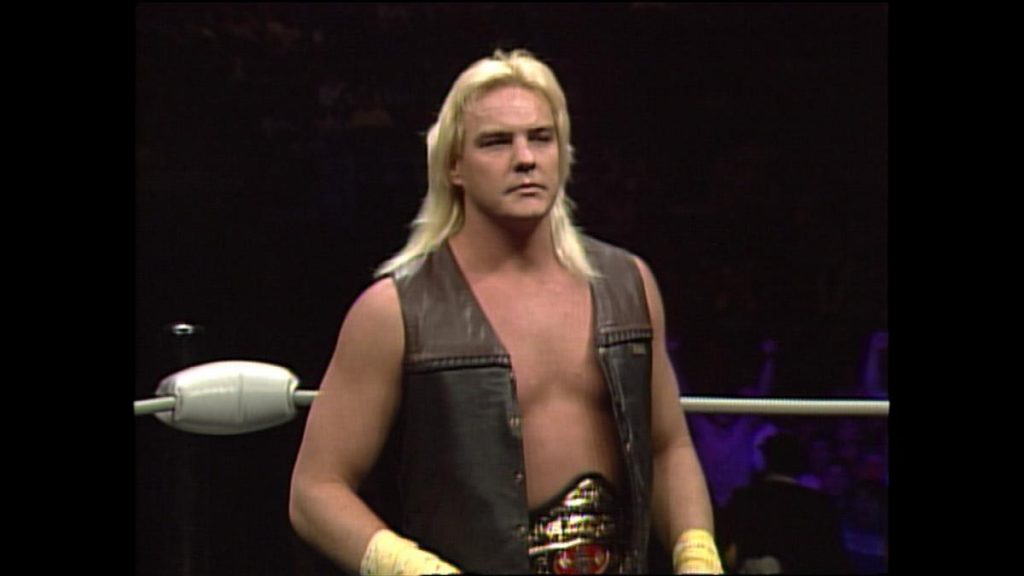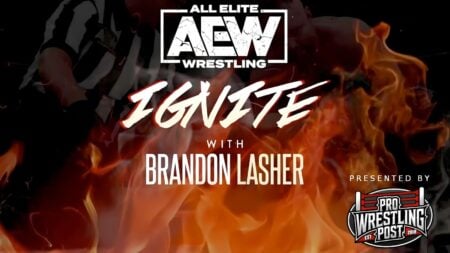Barry Windham is perhaps best known for his time in the Four Horsemen in the late-1980s. However, compared to those who were also connected to that group, his story isn’t shared as often. When you’re up there with a name like Ric Flair, it’s easy to get lost.
Windham is the son of Blackjack Mulligan and began his own career at the tender age of 19 in 1979. Standing an impressive 6’5 with flowing blond hair, he certainly cut a picture. He spent his early years in Championship Wrestling from Florida under Eddie Graham. He also worked with All Japan Pro Wrestling.
The most known portion of this was his partnership with brother-in-law Mike Rotunda. This partnership would follow them to the WWF in 1984 as the U.S. Express. Their stay in the federation wouldn’t be too long, about a year.
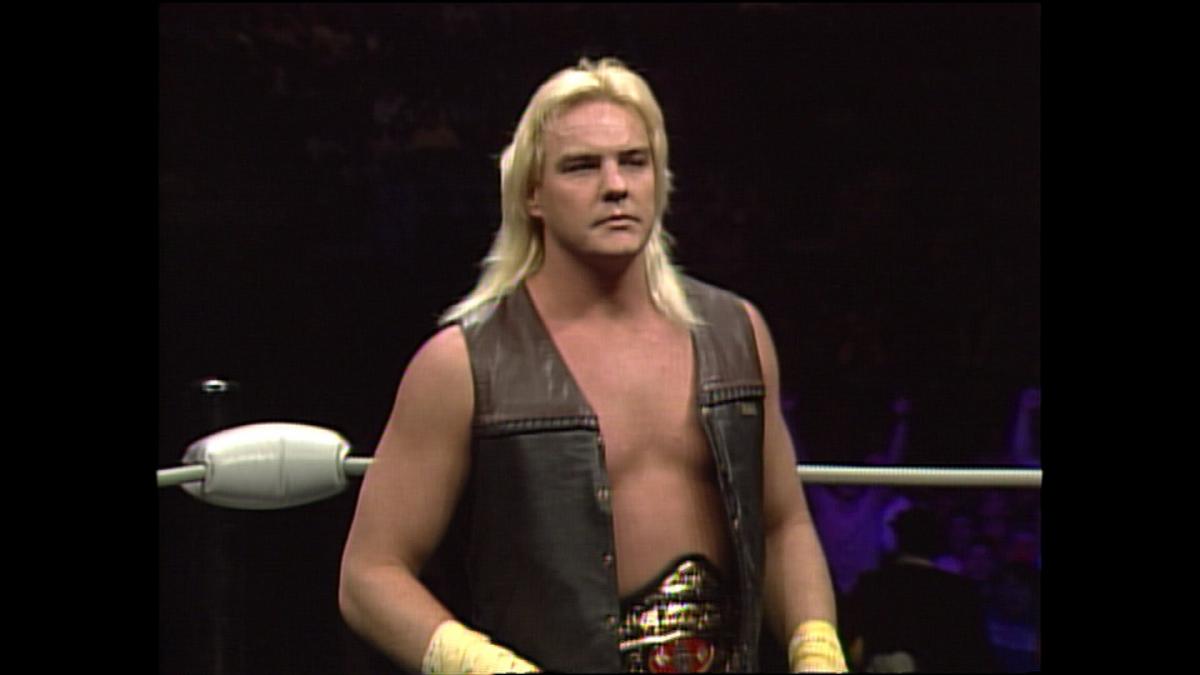
Barry Windham and The US Express
As the US Express, they would capture the WWF Tag Team Championship on two occasions. They also participated in the first WrestleMania, in which they lost the tag team titles to Nikolai Volkoff and the Iron Sheik. After a brief stint in the AWA, Barry and Mike returned to Florida. The Championship Wrestling from Florida promotion was now affiliated with the National Wrestling Alliance.

It would be here at the event Battle of the Belts II where Barry Windham would first tangle with Ric Flair. This would be over the Nature Boy’s NWA World’s Heavyweight Championship, the infamous Ten Pounds of Gold. The readers of the Wrestling Observer Newsletter would ultimately vote and declare it the match of the year for 1986.
He would also feud with Cowboy Ron Bass over the NWA Florida Heavyweight Championship. In 1986, Barry Windham would make the move to another NWA territory, Jim Crockett Promotions. Barry would again find himself working with the Nature Boy. They would clash in many encounters, some of which are arguably some of Barry’s best.
Many of these contests would be full 60-minute Broadway, and a few would even go beyond that mark. An interesting note on Windham, unlike almost every other wrestler, he didn’t work out. This seems almost counterintuitive, but it has been confirmed by many wrestlers, including Arn Anderson.
He was just naturally gifted or able to be strong, conditioned, and in shape as a wrestler in his time. Following the program with Flair, he would again move into tag team action but this time with Ronnie Garvin. Together they would win the NWA United States Tag Team Championships and feud with the legendary Midnight Express.
They would lose the titles just before the 1987 Crockett Cup tournament to Ivan Koloff and Dick Murdoch. They wouldn’t enter the tournament together, as Ronnie would team with his kayfabe brother and real-life son-in-law, Jimmy Garvin.
Barry Windham and Ric Flair
At the Crockett Cup, Barry Windham would again face off with Ric Flair in another much-lauded encounter. Also, around this time in early 1987, Barry would form an alliance with Lex Luger. Luger would eventually turn on him in the hope of joining the Four Horsemen.

In June of 1987, Barry Windham would become the inaugural NWA Western States Heritage Championship. He competed as the champion in both JCP and the affiliated UWF under Bill Watts. Windham would lose the title in late 1987 at the Bunkhouse Stampede to Larry Zybszko.
He would reunite with Luger and form the team the Twin Towers in early 1988. At the very first Clash of the Champions, they would win the NWA Tag Team Championships from Arn Anderson and Tully Blanchard of the Four Horsemen.
In a shocking turn of events, Windham would turn on Luger on April 20, reminiscent of Luger’s turn on him, in favor of the Four Horsemen. In May, he would win the tournament to crown a new NWA United States Champion, defeating Nikita Koloff. His dominant reign would last for nine months before losing the title to his rival, Luger, at the Chi-Town Rumble in February 1989.
Windham would leave the NWA in March of 1989 and return to the WWF for a brief stint. He would be known as the Widowmaker, which was the only change about him and his character. Windham would be with the company from June to October of 1989, leaving due to issues in his personal life.
He would resurface in WCW in May of 1990, once again with the Four Horsemen. The rest of 1990 would be spent concentrated on tag team matches, with various members of the Horsemen as his partners. In early 1991, he would engage in a rivalry with a young Brian Pillman.
The two would finish their rivalry at the first SuperBrawl in May of that year. That summer would see then-champion Ric Flair fired from the company and scramble to crown a new world champion.
Barry Windham and Lex Luger
Windham would be declared the number two contender to Lex Luger’s number one. They would face off at the Great American Bash and execute a brilliant double-turn. Luger would become the dastardly heel champion with Harley Race as his manager, while Windham would rise to a hugely popular babyface.
In late 1991, he would form another popular tag team with Dustin Rhodes. They would pursue the WCW Tag Team Championships but wouldn’t win the titles together in that year. Windham would be injured by Arn Anderson and Larry Zbyszko and would be out of action for a few months.
In 1992 he would feud with Stunning Steve Austin, who was the WCW Television Champion. Windham would pick up the title in May before dropping it back to Austin the following month. In September, he would again team up with Dustin Rhodes, and they would capture the WCW Tag Team Championships together.
The feel-good story was short-lived, as Barry would turn on The Natural at Clash of the Champions XXI following their loss of the titles. January of 1993 would see Windham return to singles action, and he would pursue the WCW World Heavyweight Championship. He would finally become champion by defeating The Great Muta at SuperBrawl III.
Flair would return to the company that night and attempt to present the belt to Barry, which he would rebuff. The Nature Boy and Arn Anderson would attempt to recruit Windham to the Four Horsemen once again, but he refused. Windham would have a few successful title defenses before losing the belt to Flair at Beach Blast in July. During this match, he would injure his knees, which forced him out of competition for nearly a year.
The Return at Slamboree
Windham would return at Slamboree 1994 to challenge Flair for the gold as part of the Stud Stable but was unsuccessful. In another stroke of bad luck, one of Barry’s recently healed knees would again be injured, and he would be out of wrestling for two years.
Barry Windham would return as The Stalker in the WWF in August of 1996. The gimmick itself didn’t get work, and Windham was quickly repackaged. He would form The New Blackjacks in December of 1996 with Justin Hawk Bradshaw. In early 1998, Windham would turn on Bradshaw and join Jim Cornette’s short-lived NWA faction in the WWF.
Windham would leave the WWF in May of 1998 and return to WCW. He would be associated with Eric Bischoff’s now Hollywood faction until forming a team with Curt Hennig. At SuperBrawl IX, the two would capture the WCW World Tag Team Championships. They would lose them back to Chris Benoit and Dean Malenko the following month at Uncensored 1999.
Sometime between this and the formation of the West Texas Rednecks, Windham would suffer yet another knee injury. The West Texas Rednecks consisted of Barry and his brother Kendall Windham, Hennig, and Bobby Duncum, Jr.
They would be best known for their entrance music, Rap is Crap, and their feud with Master P’s No Limit Soldiers. Duncum, Jr. would be replaced by Curly Bill shortly before the group disbanded.
The Windham Brothers Together
The Windham brothers would then team together and in August of 1999, would defeat Harlem Heat for the WCW Tag Team Championships. They would drop the belts back the following month at Fall Brawl. After this, both Barry and Kendall would be released from WCW.
They would go on to work for the World Wrestling Council in Puerto Rico. Windham would also go on to compete in his old stomping grounds of Florida for Turnbuckle Championship Wrestling. He would hold their World Championship on two occasions.
Following this run, Barry would only compete in matches sporadically for certain special occasions. He competed in MLW’s first-ever War Games as part of the Xtreme Horsemen stable. IWA Japan would hold a retirement show for Mike Rotunda in 2004 and Windham would compete there.
There would also be matches for him in 2005 and 2010. Barry Windham would serve as a producer for the WWE for a period of time, leaving the company in 2008. In late 2011, Barry would face a scary health crisis but would recover to be able to be inducted into the Hall of Fame in 2012 as part of the Four Horsemen.
Barry lives and works in Georgia and makes personal appearances for conventions and other wrestling events. Had Barry been in a different time period and/or not associated with the Four Horsemen, perhaps his star could have shown brighter on its own.
However, being able to work with legends like Ric Flair undoubtedly helped craft Barry’s legacy. While his later career was dogged by age and injury, many of his finest matches are now available to the masses on the WWE Network.

